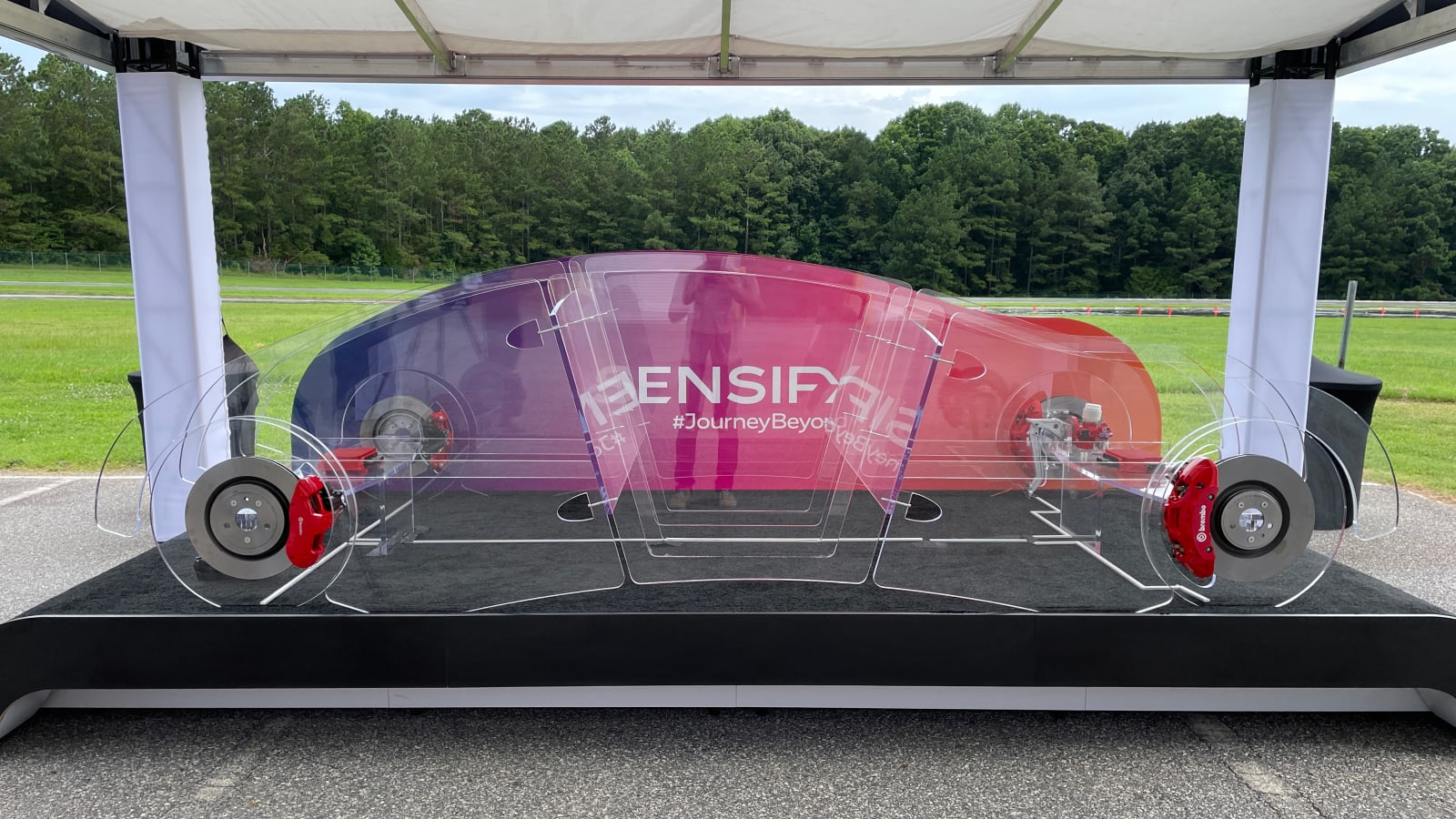It’s easy to gloss over some new braking technology called “Brembo Sensify.” On the surface, that name doesn’t mean much of anything. What this technology is for brakes in new cars, though, is nothing short of a small revolution.
When you fully depress the brake pedal of a modern car, brake pressure is distributed in the same fashion every single time. Fluid is pushed out by the master cylinder to all four corners, in turn compressing the calipers’ piston(s) and pressing the brake pads into the rotor, causing friction. On a surface level, that’s what’s going on — of course, things get a little more complicated when you introduce brake-by-wire technology, but even that is fairly normal stuff versus what Brembo Sensify is. As an indicator of how revolutionary this is going to be, brake fluid and brake lines become unnecessary with Sensify.
The best way to understand what Sensify does is to lay out an example. In an emergency stop situation involving new cars on the road today, you’re going to activate the anti-lock braking system, otherwise known as ABS. It’s a smart technology invented decades ago and has been improved ever since. The purpose is in the name. Instead of you needing to feel out and pulse the brake pedal under threshold braking to keep the wheels from locking up, the system takes care of it for you in a series of micro-pulses, applying and reducing brake pressure over and over all on its own, bringing you to the most efficient stop and allowing you to maintain some semblance of steering control. Anybody who drives, especially in wet or winter conditions, has likely felt this in action. As soon as you activate the ABS system, the pedal starts pulsing; the ABS system makes its customary noises, and you eventually grind to a halt. Hopefully.

That whole song and dance with ABS is entirely unnecessary with Brembo’s Sensify braking technology. In fact, cars with Sensify won’t even have systems like ABS or need to take advantage of traditional systems we’ve used to improve hydraulic braking systems over the years like electronic brake force distribution (EBD). To tell you why as succinctly as possible, that’s because this system is capable of applying and retracting brake pressure to any wheel independently of another with practically instantaneous response. It replaces all of these innovations — ABS, EBD etc. — we’ve made to improve hydraulic-based systems with a single new system that can do everything quicker.
To use an analogy, Sensify is like hub motors for electric cars, but instead of accelerative control, Brembo has total decelerative control. In the case of emergency stops that would otherwise use ABS, the Sensify system is able to bring you to a halt by utilizing a large array of sensors and a combination of new braking system hardware consisting of new caliper, brake “line” and brake actuation technology. In a full emergency stop, those sensors are able to suss out the maximum performance of the tire, and get the brakes to apply the exact amount of pressure that provides the quickest stopping distance without the ABS micro-pulses. It’s smooth, calm and silent sailing from whatever speed you’re at, to 0 mph.
The mechanics of the system are even massively different from brakes in new cars today, and there are multiple setups that Brembo is offering. The most advanced setup uses electro-mechanical calipers at all four corners. These calipers are actuated by tiny electric motors that squeeze the pads onto the rotor when you press the brake pedal. Your brake pedal is essentially just an electric button in this case, sending a signal out to an ECU that in turn tells the brake calipers what to do. There are no traditional brake “lines” here, and because an electric motor is used as the actuator, there’s no brake fluid either. You may be asking, where’s the backup system in this setup in case of a loss of power to the car? Brembo says that vehicles with a full electro-mechanical braking system will come with a backup power supply that will be utilized in such situations.
Jamming on the brakes mid-corner is a recipe for disaster in many cases, and while the ABS system in the Model 3 Performance handled this obstacle with ease, the Sensify system did it even better. We were able to continue tracing our line in the corner without any issue, and the computer did an excellent job of ensuring the car remained steady and predictable under heavy braking. Even when you’re going quickly enough that a touch of understeer is the car’s first direction, you can quickly remedy that with steering force that is helped by the braking patterns. Brembo even had us intentionally upset the vehicle by applying full brake force at 75 mph in a curve, then jerking the wheel left and right. There wasn’t even a hint of an out-of-control feeling. After that stop, Brembo presented the data explaining that the car would oscillate brake pressure on the left rear and right rear brakes individually with each yank of the wheel to one direction or the other in an effort to keep the car under control. We’ll also note that all of these maneuvers were done with stability control completely defeated and in the Model 3 Performance’s “Track Mode.”
The final maneuver Brembo threw at us was a quick left-right that was to be completed under heavy braking from fairly high speed. Once again, the Sensify car outperformed the traditional-braking Model 3 Performance in both maneuverability and control. Depending on the severity of the steering angle you apply under braking, the system will even aid you with the smallest dab of oversteer to help guide the rear end around controllably through a corner.
Brembo isn’t throwing any quantifiable improvements in braking distance at the wall yet, but engineers say that’s largely because the system is still in testing. An easier way to get better stopping distances out of a car is to just upgrade the tires. Sensify comes with lots of other positives outside of extra-smooth stops and independent brake control, though. For one, it’s a big win in packaging, as it gives OEMs more freedom with their platform and electrical architecture design. You no longer need to run brake lines throughout the car, and the ABS system can be trashed. Similar to today’s brake-by-wire systems, you can also adjust the braking feel and response. A “comfort” brake mode would leave you with a soft and progressive pedal, while a “track” brake mode could provide a super-stiff and sensitive pedal feel.







